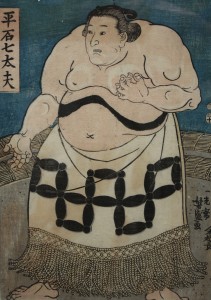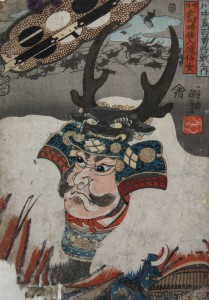
TUSCALOOSA, Ala. — As part of the annual Sakura Festival, a selection of Japanese woodblock prints from the collection of Dr. and Mrs. William T. Price is on display in the Ferguson Center Gallery on The University of Alabama campus.
The exhibit, “Of Sumo and Samurai: Japanese Woodblock Prints from the Collection of Dr. and Mrs. William T. Price,” will run until March 29.
Price, a Tuscaloosa native, is a 1943 alumnus of The University of Alabama. Price first began collecting art in 1953 when he bought two woodblocks in Japan while he was serving as a neurosurgeon in the United States Army Medical Corps.
Since then, his collection has grown to include an array of Central Asian carpets and pottery, Islamic prayer rugs, South Asian and Southeast Asian sculptures and more than 500 Japanese woodblock prints.
Dr. Catherine Pagani, chair of the art and art history department, curated the exhibit with assistance of students studying art history.
According to Pagani, the sumo prints are of specific sumo wrestlers who were popular in their day.
“Prints such as these were purchased by the fans of these wrestlers,” she said. “And, just as sports figures today move in and out of public popularity, so too did sumo wrestlers. Such prints were a disposable form of art that could be replaced when another wrestler came into favor.”

The samurai prints depict brave warriors from the past and include epic battles scenes that bring to life well-known incidents in history.
“Portraits of specific samurai tell of their bravery in battle and their dignity when faced with defeat,” Pagani said. “Several prints chronicle the stories of well-known figures who committed seppuku, or ritual suicide, rather than die at the hands of their enemies.”
Pagani describes the process of producing the prints as a business enterprise with many people involved, which is different from how many artworks are developed with a single artist. She explained that publishers would assemble a team that included the image’s designer, wood carvers and a printer, who were all involved in the creation of the final prints.
“For each image there could be hundreds or thousands of prints produced,” she said. “We are pleased to feature such a fascinating subject as sumo and samurai in this exhibition.”
UA’s annual Sakura Festival is a celebration of Japanese culture with numerous events. In Japanese culture the time of year when the cherry blossom trees bloom, known as ohanami, is a time to remember the paradoxically fleeting yet enduring nature of life, which is symbolized by the moment when a cherry blossom petal falls from its branch to earth below. In homage to this tradition and Alabama’s ties with Japan, The University of Alabama has hosted the Sakura Festival for the last 26 years.
The art and art history department is part of UA’s College of Arts and Sciences, the University’s largest division and the largest liberal arts college in the state. Students from the College have won numerous national awards including Rhodes Scholarships, Goldwater Scholarships and memberships on the USA Today Academic All American Team.
Contact
Kelli Wright, communications specialist, College of Arts and Sciences, 205/348-8539, khwright@as.ua.edu
Source
Dr. Catherine Pagani, 205/348-9944, cpagani@as.ua.edu